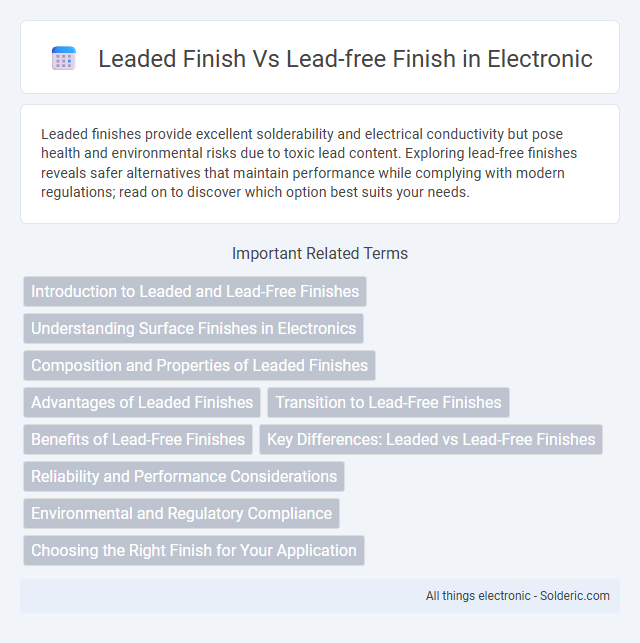Leaded finishes provide excellent solderability and electrical conductivity but pose health and environmental risks due to toxic lead content. Exploring lead-free finishes reveals safer alternatives that maintain performance while complying with modern regulations; read on to discover which option best suits your needs.
Comparison Table
| Feature | Leaded Finish | Lead-Free Finish |
|---|---|---|
| Toxicity | Contains lead; toxic and hazardous | Non-toxic; environmentally safe |
| Regulatory Compliance | Restricted by RoHS and other regulations | Meets RoHS and global safety standards |
| Cost | Generally lower initial cost | Typically higher cost due to materials and processing |
| Durability | Good solderability and long-term reliability | Improved environmental resistance; can be less reliable if improperly applied |
| Melting Point | Low melting point (~183degC) | Higher melting points (217-227degC), requires adjusted processes |
| Environmental Impact | High; leads to soil and water contamination | Low; safer for disposal and recycling |
| Application | Traditional electronics and plumbing | Modern electronics, food-grade, and medical equipment |
Introduction to Leaded and Lead-Free Finishes
Leaded finishes, traditionally used in soldering processes, contain a significant percentage of lead, offering excellent wetting properties and lower melting points for reliable electrical connections. Lead-free finishes eliminate toxic lead, using alternative metals like tin, silver, and copper to meet environmental regulations such as RoHS compliance. Your choice between these finishes impacts solderability, joint strength, and long-term device reliability in electronic manufacturing.
Understanding Surface Finishes in Electronics
Leaded finish and lead-free finish are crucial types of surface finishes used in electronics to protect circuit boards and ensure solderability. Leaded finishes, typically composed of tin-lead alloys, offer excellent machinability and reliable solder joints, while lead-free finishes, often based on alloys like SAC (tin-silver-copper), meet environmental regulations such as RoHS and support sustainable manufacturing. Understanding the differences in thermal properties, wetting behavior, and compliance requirements helps you select the optimal surface finish for durability and performance in your electronic assemblies.
Composition and Properties of Leaded Finishes
Leaded finishes primarily consist of tin and lead alloys, offering superior malleability and excellent solderability due to their low melting points and good wetting properties. These finishes provide strong mechanical strength and reliable electrical conductivity, making them ideal for electronic solder joints. However, the presence of lead raises environmental and health concerns, prompting restrictions and shifts toward lead-free alternatives.
Advantages of Leaded Finishes
Leaded finishes offer superior wettability and improved solder joint reliability, especially in high-performance electronic assemblies. Their lower melting point enables easier rework and repairs, reducing production time and cost. Enhanced mechanical strength and fatigue resistance in leaded finishes contribute to longer-lasting, robust electronic connections.
Transition to Lead-Free Finishes
The transition to lead-free finishes in electronics manufacturing addresses environmental and health concerns associated with lead exposure. Lead-free finishes, such as tin-silver-copper alloys, offer comparable reliability and solderability while complying with regulations like RoHS (Restriction of Hazardous Substances). Industry adoption accelerates as manufacturers optimize processes to achieve durable, cost-effective lead-free solder joints without compromising product performance.
Benefits of Lead-Free Finishes
Lead-free finishes offer significant environmental and health benefits by eliminating lead toxicity risks, making them safer for manufacturers, consumers, and ecosystems. These finishes improve compliance with global regulations such as RoHS and REACH, facilitating market access and reducing legal liabilities. Enhanced corrosion resistance and solderability in lead-free finishes also contribute to longer-lasting and more reliable electronic components.
Key Differences: Leaded vs Lead-Free Finishes
Leaded finishes contain lead compounds that provide excellent solderability and corrosion resistance but raise health and environmental concerns due to lead toxicity. Lead-free finishes utilize alternative metals like tin, silver, or copper, improving safety and compliance with regulations such as RoHS while sometimes presenting challenges like higher soldering temperatures and potential reliability issues. Key differences lie in their composition, environmental impact, regulatory compliance, and performance characteristics under thermal and mechanical stress.
Reliability and Performance Considerations
Leaded finishes, such as tin-lead solder, offer excellent wetting properties and lower melting points, which enhance solder joint reliability and reduce thermal stress during assembly. Lead-free finishes, commonly made with tin-silver-copper alloys, provide improved environmental compliance but often require higher reflow temperatures, potentially impacting component longevity and increasing the risk of thermal fatigue. Performance trade-offs include leaded finishes delivering consistent mechanical strength and electrical conductivity, while lead-free finishes demand optimized process controls to achieve comparable reliability in high-reliability electronic applications.
Environmental and Regulatory Compliance
Leaded finishes contain toxic lead, posing significant environmental hazards and strict regulatory restrictions across many countries, including RoHS compliance in the EU that limits lead content in electronics. Lead-free finishes use safer alternatives like tin-silver-copper alloys, aligning with global environmental standards and minimizing health risks associated with lead exposure. Choosing lead-free finishes helps ensure your products meet current environmental regulations while supporting sustainable manufacturing practices.
Choosing the Right Finish for Your Application
Selecting the appropriate finish depends on the application's environmental and health requirements, with lead-free finishes offering a safer alternative that meets modern regulatory standards such as RoHS and REACH. Leaded finishes provide superior solderability and durability, making them suitable for legacy electronics and high-reliability industrial applications. Evaluating factors like thermal performance, compliance mandates, and product lifespan ensures an optimal choice between leaded and lead-free finishes for your specific use case.
leaded finish vs lead-free finish Infographic

 solderic.com
solderic.com